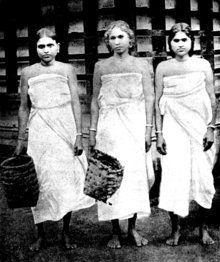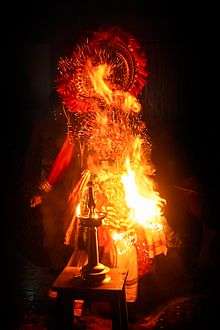Ambalavasi
Ambalavasi (Ampalavasi) is a generic name for a group of castes among Hindus in Kerala, India, who render temple services. Some Ambalavasi castes are patrilineal, while the others are matrilineal. Those that practise matrilineality share many cultural similarities with the Nair caste and, according to some anthropologists, may be related to them. Their ritual rank in Hinduism lies somewhere between the Brahmin castes and the Nairs.[1][2]
Castes and professions

The castes which comprised the Ambalavasi community each contained only a few members.
Pushpaka Brahmins
Others
Kazhakams
Kazhakams or Ambalakkazhakams refer to associations of ambalavasi peoples in a temple to perform specific duties in the temple.[5] The Malayalam or Tamil term Kazhaka is believed to be originated from the Sanskrit word घटकः (ghaṭakaḥ) meaning a unit or part or component.
Temple arts


Sri. Chendamangalam Unnikrishna Maarar in action - In the middle.
Traditionally, Ambalavasis are associated with various types of temple arts. Earlier, each of these temple arts were performed only by specific Ambalavasi castes. Now there is no community or caste barrier.
| Temple Art | Associated Ambalavasi castes |
|---|---|
| Koodiyattam | Chakyar |
| Kooth | Chakyar,[6] Nangyar (women of Nambiar) |
| Certain roles of Krishnanattam | Nambeesan or Pushpaka Unni[7] |
| Mizhavu (Musical Instruemnt) | Nambiar[8] |
| Kuzhithalam (Musical Instruemnt) | Nangyar (women of Nambiar) |
| Thullal | Nambiar |
| Theeyattu | Theeyatt Unni, Thiyyadi Nambiar |
| Pathakam | Nambiar[9] |
| Vadyams (Musical Instruments) like Chenda, Idakka, Udukku etc. | Marar |
| Panchavadyam | Marar |
| Sopanasangeetham | Marar, Pothuval |
| Brahmanippattu | Brahmani (women of Nambeesan)[10][11] |
Temple types
They lived in villages either where the land was owned solely by one Nambudiri Brahmin family or where the land was owned by a temple, the running of which was in the control of a group of Nambudiri families. The latter villages were called sanketams.[2]
The temples in which they worked comprised four basic types:[2]
- Those in sanketams were large and were dedicated to deities which were worshipped throughout India, such as Shiva and Vishnu.
- Private temples, owned by Nambudiri families, which were the smaller versions of those found in the sanketams.
- The private temples of the royal lines, feudatory chiefs and vassal chiefs of what is now Kerala, which were dedicated to Bhagavati (Bhadrakali)
- Village temples dedicated to Bhagavati and run by senior Nairs who had been appointed by local rulers
References
- 1 2 3 Fuller, Christopher J. (1976). The Nayars Today. Cambridge University Press. p. 13. ISBN 978-0-52129-091-3.
- 1 2 3 4 5 6 7 8 9 Gough, Kathleen (1961). "Nayars: Central Kerala". In Schneider editor-link=David M. Schneider, David Murray; Gough, Kathleen. Matrilineal Kinship. University of California Press. pp. 309–311. ISBN 978-0-520-02529-5.
- 1 2 3 4 Report of the Commission for Reservation of Seats in Educational Institutions, Kerala, 1965. Kerala: Commission for Reservation of Seats in Educational Institutions, Kerala, India. 1966. p. 140.
- ↑ People of India - India's Communities N-Z. Oxford University Press. 1998. pp. 2861–2863.
- ↑ People of India - India's Communities N-Z. Oxford University Press. 1998. pp. 3605–3607.
- ↑ "Latest India News | Breaking News | World & Business News | Sports & Entertainment news". Expressbuzz.com. Retrieved 2013-09-30.
- ↑ Sikora,, Martha Bush (1993). Krishnanattam. Oxford & IBH Publishing Company.
- ↑ Dutta, Madhumita (2008). Let's Know Music and Musical Instruments of India. Star Publications. p. 16.
- ↑ "Padakam, the poor cousin of Chakyarkoothu - Times of India". The Times of India. Retrieved 2018-01-16.
- ↑ Nampoothiri, M.V. Vishnu (2012). Folklore: The Identity of Culture. Department of Information & Public Relations, Government of Kerala. p. 73.
- ↑ V.T., Induchudan (1969). The Secret Chamber: A Historical, Anthropological & Philosophical Study of the Kodungallur Temple. Cochin Devaswom Board. p. 260.